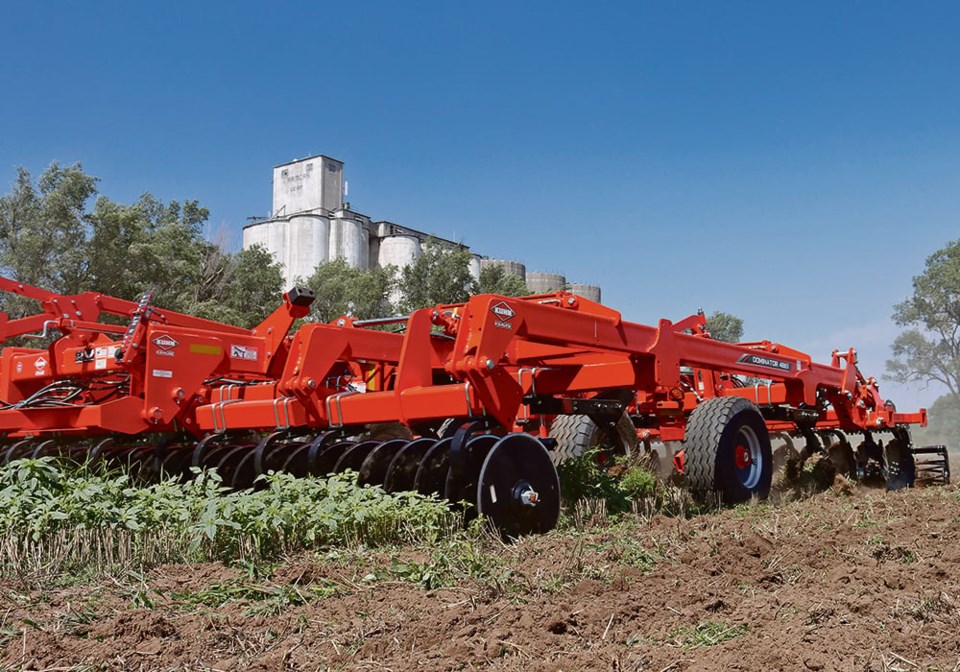WESTERN PRODUCER – Tillage implements have undergone a lot of changes over the past decade or two, with a lot of design influence coming from European manufacturers that have broken into the North American market.
One of those brands, Kuhn, has become a significant player in the tillage segment here since it acquired Kansas-based implement manufacturer Krause in 2011.
This year, Kuhn announced it has updated the design of its Dominator combination disc ripper implement that uses both shanks and discs.
“We’re replacing the two previous models, the 4856 and 4860,” said Curt Davis, direct of marketing and product management at Kuhn. “The 4857 and 4861 are the new models. These are the Dominator disc rippers we’ve had in the marketplace for several years. We’ve made some improvements to them to improve reliability, durability and uptime for the customer.”
The Dominators use coulters up front, shanks in the middle and then a disc conditioner on the rear. Behind that is a choice of rolling basket field finishers. Both models of Dominator are designed for cutting residue, removing soil compaction, then mixing the residue and levelling the field finish.
The horsepower requirement is different between the two models, and it’s because of the shank spacing. The 4857 is on an 18-inch shank spacing and requires a recommended 39 to 47 horsepower per shank. The 4861 is on a 24-inch shank spacing, and it demands 40 to 50 h.p. per shank.
“The difference between the machines is really the application of use,” explained Davis. “It comes down to where a customer is really needing the maximum fracture from the 4857 versus the maximum productivity of the 4861, where the same number of shanks on a wider spacing is a wider machine. That’s where that horsepower requirement comes into play. The same number of shanks but with more discs, so the horsepower requirement goes up a little bit with more ground engagement.”
Both implements are similar in design and can work from eight to 16 inches deep, but the 4857 offers more soil fracturing capability because of the increased number of shanks.
“The concept is the same, but the actual features and width are different between the two,” said Davis. “The 4857 is really geared toward irrigated corn, potatoes, something where you’re going to have more truck traffic on the field. If you think about chopping corn for a feedlot, it’s going to have a lot of truck traffic. It (the 4857) is going to give that maximum fracture, because the shanks are closer together at 18 inches. It’s going to remove more compaction.
“Going the other way with the 4861, with the shanks on a wider spacing, you don’t get as much soil fracture, but you get (working) width. You can get up to 26 feet wide. (The 4857 tops out at 19 feet, six inches.) With the increase in tractor horsepower we’re seeing from Case IH, John Deere and Agco, that really starts to fit with productivity. You still get compaction removal, but it’s not quite as aggressive as the 4857.”
The main updates to the new models are on the rear disc conditioner section.
“We had a hub that was very large,” said Davis. “We found one we’ve been using on another machine that has a smaller envelope and very good durable life. We’ve been using it on our high-speed disc. It has performed extremely well. It has a sealed bearing so it’s maintenance free. No daily greasing required. It has a new C-arm that the hub bolts to, so it’s very easy to replace a blade if you need to.
“We also get about 10 percent more soil and residue flow through the disc conditioner compared to the previous design. So it can really work in adverse conditions, wet soil, heavy residue.”
Aside from the difference in deep ripping capability, both models should leave a field finish that looks pretty similar.
“There’s about a five to 10 percent difference in residue incorporation between the two,” explained Davis. “Sometimes it might be barely recognizable from the tractor seat which one is incorporating more.”
Kuhn will begin building the new Dominators this spring in its Hutchinson, Kansas, plant. Dealers can order in December, and delivery to customers is expected to begin in late spring of 2024.
Pricing for the 4857 ranges from US$101,259 to $195,257 on a list price basis. The 4861 starts at $130,278 and goes up to $240,657.

